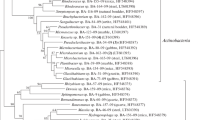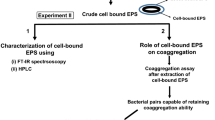Abstract
Both biofilm formations as well as planktonic cells of water bacteria such as diverse species of the Legionella genus as well as Pseudomonas aeruginosa, Klebsiella pneumoniae, and Escherichia coli were examined in detail by Raman microspectroscopy. Production of various molecules involved in biofilm formation of tested species in nutrient-deficient media such as tap water was observed and was particularly evident in the biofilms formed by six Legionella species. Biofilms of selected species of the Legionella genus differ significantly from the planktonic cells of the same organisms in their lipid amount. Also, all Legionella species have formed biofilms that differ significantly from the biofilms of the other tested genera in the amount of lipids they produced. We believe that the significant increase in the synthesis of this molecular species may be associated with the ability of Legionella species to form biofilms. In addition, a combination of Raman microspectroscopy with chemometric approaches can distinguish between both planktonic form and biofilms of diverse bacteria and could be used to identify samples which were unknown to the identification model. Our results provide valuable data for the development of fast and reliable analytic methods based on Raman microspectroscopy, which can be applied to the analysis of tap water-adapted microorganisms without any cultivation step.

Biofilm and planktonic forms of L. pneumophila ssp. pneumophila exhibit different Raman spectra. L. pneumophila ssp. pneumophila in biofilms display a significant increase in the synthesis of lipids compared to the planktonic state





Similar content being viewed by others
References
Andrews JS, Rolfe SA, Huang WE, Scholes JD, Banwart SA (2010) Biofilm formation in environmental bacteria is influenced by different macromolecules depending on genus and species. Environ Microbiol 12(9):2496–2507
Donlan RM (2002) Biofilms: microbial life on surfaces. Emerg Infect Dis 8(9):881–890
Exner M, Kramer A, Lajoie L, Gebel J, Engelhart S, Hartemann P (2005) Prevention and control of health care-associated waterborne infections in health care facilities. Am J Infect Control 33(5):S26–S40
Potera C (1996) Biofilms invade microbiology. Science 273(5283):1795–1797
Stewart CR, Muthye V, Cianciotto NP (2012) Legionella pneumophila persists within biofilms formed by Klebsiella pneumoniae, Flavobacterium sp., and Pseudomonas fluorescens under dynamic flow conditions. PLoS One 7(11):e50560
Brown MR, Allison DG, Gilbert P (1988) Resistance of bacterial biofilms to antibiotics: a growth-rate related effect? J Antimicrob Chemother 22(6):777–780
Gilbert P, Collier PJ, Brown MR (1990) Influence of growth rate on susceptibility to antimicrobial agents: biofilms, cell cycle, dormancy, and stringent response. Antimicrob Agents Chemother 34(10):1865
Nahar Q, Fleißner F, Shuster J, Morawitz M, Halfpap C, Stefan M, Langbein U, Southam G, Mittler S (2014) Waveguide evanescent field scattering microscopy: bacterial biofilms and their sterilization response via UV irradiation. J Biophoton 7(7):542–551
Oliver JD (2005) The viable but nonculturable state in bacteria. J Microbiol 43(1):93–100
Oliver JD (2000) The viable but nonculturable state and cellular resuscitation. Microbial biosystems: new frontiers. Atlantic Canada Society for Microbial Ecology, Halifax, pp 723–730
Yee RB, Wadowsky RM (1982) Multiplication of Legionella pneumophila in unsterilized tap water. Appl Environ Microbiol 43(6):1330–1334
Carson LA, Favero MS, Bond WW, Petersen NJ (1972) Factors affecting comparative resistance of naturally occurring and subcultured Pseudomonas aeruginosa to disinfectants. Appl Microbiol 23(5):863–869
Pahlow S, Meisel S, Cialla-May D, Weber K, Rösch P, Jürgen P (2015) Isolation and identification of bacteria by means of Raman spectroscopy. Adv Drug Deliv Rev. doi:10.1016/j.addr.2015.04.006
Beier BD, Quivey RG, Berger AJ (2012) Raman microspectroscopy for species identification and mapping within bacterial biofilms. AMB Express 2(1):1–6
Chao Y, Zhang T (2012) Surface-enhanced Raman scattering (SERS) revealing chemical variation during biofilm formation: from initial attachment to mature biofilm. Anal Bioanal Chem 404(5):1465–1475
Samek O, Al‐Marashi JFM, Telle HH (2010) The potential of Raman spectroscopy for the identification of biofilm formation by Staphylococcus epidermidis. Laser Phys Lett 7(5):378–383
Kusić D, Kampe B, Rösch P, Popp J (2014) Identification of water pathogens by Raman microspectroscopy. Water Res 48:179–189
Kloß S, Kampe B, Sachse S, Rösch P, Straube E, Pfister W, Kiehntopf M, Popp J (2013) Culture independent Raman spectroscopic identification of urinary tract infection pathogens: a proof of principle study. Anal Chem 85(20):9610–9616
Bocklitz T, Walter A, Hartmann K, Rösch P, Popp J (2011) How to pre-process Raman spectra for reliable and stable models? Anal Chim Acta 704(1):47–56
Development Core Team R (2011) R: a language and environment for statistical computing. R Foundation for Statistical Computing, Vienna
Morháč M, Kliman J, Matoušek V, Veselský M, Turzo I (1997) Background elimination methods for multidimensional coincidence gamma-ray spectra. Nucl Instrum Methods in Phys Res Sect A 401(1):113–132
Cortes C, Vapnik V (1995) Support-vector networks. Mach Learn 20(3):273–297
Puppels GJ, De Mul FFM, Otto C, Greve J, Robert-Nicoud M, Arndt-Jovin DJ, Jovin TM (1990) Studying single living cells and chromosomes by confocal Raman microspectroscopy. Nature 347:301–303
Fischer WB, Eysel HH (1992) Polarized Raman spectra and intensities of aromatic amino acids phenylalanine, tyrosine and tryptophan. Spectrochim Acta A: Mol Spectrosc 48(5):725–732
Williams AC, Edwards HGM (1994) Fourier transform Raman spectroscopy of bacterial cell walls. J Raman Spectrosc 25(7-8):673–677
Oliver JD (2000) Problems in detecting dormant (VBNC) cells, and the role of DNA elements in this response. In: Jansson JK, van Elsas JD, Bailey M (eds) Tracking genetically-engineered microorganisms. Landes Biosciences, Georgetown, pp 1–15
Ciobotă V, Burkhardt E-M, Schumacher W, Rösch P, Küsel K, Popp J (2010) The influence of intracellular storage material on bacterial identification by means of Raman spectroscopy. Anal Bioanal Chem 397(7):2929–2937
James BW, Mauchline WS, Dennis PJ, Keevil CW, Wait R (1999) Poly-3-hydroxybutyrate in Legionella pneumophila, an energy source for survival in low-nutrient environments. Appl Environ Microbiol 65(2):822–827
Piao Z, Sze CC, Barysheva O, Iida K-i, Yoshida S-i (2006) Temperature-regulated formation of mycelial mat-like biofilms by Legionella pneumophila. Appl Environ Microbiol 72(2):1613–1622
Steinberger RE, Holden PA (2005) Extracellular DNA in single- and multiple-species unsaturated biofilms. Appl Environ Microbiol 71(9):5404–5410
Whitchurch CB, Tolker-Nielsen T, Ragas PC, Mattick JS (2002) Extracellular DNA required for bacterial biofilm formation. Science 295(5559):1487
Karatzoglou A, Smola A, Hornik K (2013) kernlab: kernel-based machine learning lab. R Foundation for Statistical Computing, Vienna
Presti FL, Riffard S, Vandenesch F, Etienne J (1998) Identification of Legionella species by random amplified polymorphic DNA profiles. J Clin Microbiol 36(11):3193–3197
Moliner C, Ginevra C, Jarraud S, Flaudrops C, Bedotto M, Couderc C, Etienne J, Fournier P-E (2010) Rapid identification of Legionella species by mass spectrometry. J Med Microbiol 59(3):273–284
Van de Vossenberg J, Tervahauta H, Maquelin K, Blokker-Koopmans CHW, Uytewaal-Aarts M, van der Kooij D, van Wezel AP, van der Gaag B (2013) Identification of bacteria in drinking water with Raman spectroscopy. Anal Methods 5(11):2679–2687
Helm D, Labischinski H, Schallehn G, Naumann D (1991) Classification and identification of bacteria by Fourier-transform infrared spectroscopy. J Gen Microbiol 137(1):69–79
Vlassov VV, Laktionov PP, Rykova EY (2007) Extracellular nucleic acids. Bioessays 29(7):654–667
Lang S, Philp JC (1998) Surface-active lipids in rhodococci. Antonie Van Leeuwenhoek 74(1-3):59–70
Sutherland IW (2001) Biofilm exopolysaccharides: a strong and sticky framework. Microbiology 147(1):3–9
Sutherland IW (2001) The biofilm matrix—an immobilized but dynamic microbial environment. Trends Microbiol 9(5):222–227
Acknowledgments
The authors gratefully acknowledge the assistance of Dr. Oliwia Makarewicz in laser scanning microscopy analysis and Prof. Dr. Eberhard Straube and Svea Sachse for providing us with the bacterial strains and for useful discussions. Funding of the research project RiMaTH (02WRS1276E) from the Federal Ministry of Education and Research, Germany (BMBF), is gratefully acknowledged. Financial support of the European Union via the EU project “HemoSpec” (CN 611682) and of the BMBF via the Integrated Research and Treatment Center “Center for Sepsis Control and Care” (FKZ 01EO1002) is highly acknowledged. This project was realized within the InfectoGnostics Research Campus Jena.
Author information
Authors and Affiliations
Corresponding author
Electronic supplementary material
Below is the link to the electronic supplementary material.
ESM 1
(PDF 1.60 mb)
Rights and permissions
About this article
Cite this article
Kusić, D., Kampe, B., Ramoji, A. et al. Raman spectroscopic differentiation of planktonic bacteria and biofilms. Anal Bioanal Chem 407, 6803–6813 (2015). https://doi.org/10.1007/s00216-015-8851-7
Received:
Revised:
Accepted:
Published:
Issue Date:
DOI: https://doi.org/10.1007/s00216-015-8851-7




